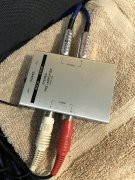NeverSatisfied
Chief Journeyman
Will be watching with interest.There seems to be a lot of activity in the forum with people building/restoring/optimizing their vintage turntables. It's impressive just how far some have gone in order to bring these electro-mechanical marvels back to Day 1 (or better) operation.
Myself, prior to joining this forum my plan was simply to restore my old audio system & then feed it with a modded CD player supplemented by the occasional DVD and the obscure stuff only found on the internet. In other words, I didn't have plans to play any vinyl...
Of course, hanging out in here & seeing how much fun the vinyl & reel-to-reel crowd are having, it seemed only right to go ahead of see if I could tackle my old Dual 606 and undo the years of neglect. And if I'm going to do that, then I might as well see if I can bring back my first-ever preamp, a PL 2000.
****
Once I cleaned up the turntable & it seems to be ready for duty, now I was wondering how was I going to best take full sonic advantage of this analog input? Restoring the old PL 2000 input stage was a given, but then again how would I be able to figure out (quantify) just how far away I was from today's State Of The Art? (As in, how do I ensure that I have the lowest possible background noise level when enjoying vinyl?)
****
One thing I've learned over my career is that the single hardest scenario to troubleshoot/fix/characterize/optimize/POOGE/hot rod/comprehend is when you only have ONE item to work with -- that is, no constant unmodified device to compare my progress against in order to keep from lying to yourself. Sure, with high quality test gear you can document the improvements made over time...the problem is, some of what makes us enjoy the listening experience the most seems to be just beyond the reach of what 'mere mortal' test equipment can resolve. (!)
****
So, when Gepetto pointed out that I could explore the area of battery-powered phono preamps featuring an affordable price of admission (plus the fact that this same preamp had created quite a stir in the audiophile community back in the day), I was instantly sold:
View attachment 60209
As a matter of fact, it was so affordable that I was recently able to further improve my test setup with a 2nd identical (think control) phono preamp -- it arrived early...today! From everything I can tell, it is actually a NOS cream puff:
View attachment 60210
To me, this is the best of all worlds, for I now have the opportunity to compare & contrast 3 different phono stages - eventually having the PL 2000 vs. a control unit vs. a unit upgraded by swapping out the old parts with today's low-noise/improved versions of the same. (!)
Done in a disciplined fashion, I can take this just as far as my interest in reproducing high-quality music from vinyl or my system's ability to resolve these differences...
NOTE: To make sure that I'm not just deluding myself with 'expectation bias' my plan is to record the sound of the circuit in question, make the mod, and then record the same test tone or music sample again...and then by using this software be able to clearly define the difference made. (if any!)
****
The Perspective:
When you read my subsequent posts, please keep the following hand-drawn graph in mind.
View attachment 60211
Once I get the rest of the system restored, my plan is to then take these $20 battery-powered phono stages & see how far I can push them from their 'near zero' starting point towards the knee of the curve on this hand-drawn graph.
Of course, in the unpopulated state the curve above is a pure abstraction that conveys no meaning, so I am going to populate it with a selection of battery-powered phono stages for sale *right now*. Admittedly this is an unscientific sample...but at the same time, my hope is that it provides some food for thought for anyone else tinkering with their vinyl in 2022.
FWIW --
For most of my audio life, I completely avoided records, fully believing that it was a fool’s errand because digital was superior in every way. Other than my first turntable back when I was a teenager I hadn’t owned one in close to 35 years, until about 2 years ago.
That’s when I got my first PL8000 just because I wanted a complete PL system from turntable to speakers and not because I thought i would use it much. Man was I wrong about vinyl, I FINALLY get it. It not only sounds more alive but the act of getting up out of the chair to change records keeps me more focused on the music. Meaning that often after loading 5 CD’s in the changer or firing up the streamer, it wouldn’t be very long before I was dosing off or not really paying attention to the music.


